Matchday two of the Champions League group stage saw Inter travel to Shakhtar Donetsk, looking to improve on their opening draw at home to Borussia Monchengladbach. Meanwhile, Shakhtar were in high spirits after picking up an impressive 3-2 victory away at Champions League royalty, Real Madrid. Despite the goal-filled games both sides were involved in during matchday one, this encounter resulted in a goalless draw – a result that would disappoint Serie A Inter more considering their dominance throughout the game. This tactical analysis will provide some insight into the tactics deployed by both sides: how Inter controlled a large portion of the game thanks to players like Arturo Vidal, and how Shakhtar combatted the attacks.
Line-ups
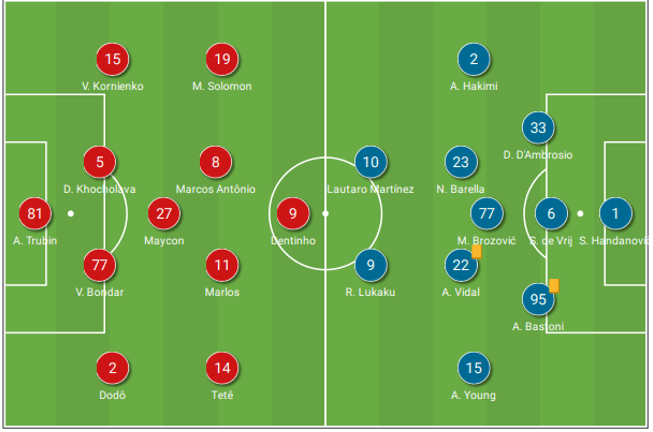
Home side Shakhtar deployed a 4-1-4-1 formation in an attempt to pack out the central area to limit Inter’s options going forward. Maycon acted as the anchorman of the engine room, and did a stellar job, making three recoveries as well as winning all five of the defensive duels he was involved in. In front of him were Marlos and Marcos Antonio, with Tete and Manor Solomon occupying the wide areas. Dentinho initially lead the line, but his night was cut short after just 15 minutes – Taison replaced him. The back four consisted of Dodo and Viktor Kornienko as full-backs, and Valeriy Bondar partnered alongside Davit Khockolava.
Inter set out to dominate the game, trying to stretch the home side using a 3-5-2 formation. Stefan de Vrij commanded the Inter back three, with Ashley Young and Achraf Hakimi operating as wing-backs. In the middle, the Italians went with a physical trio of Arturo Vidal, Nicolo Barella, and Marcelo Brozovic. Romelu Lukaku and Lautaro Martinez lead the line.
Inter’s defensive strategies
The opening 15 minutes or so saw an even contest taking place, with neither side really controlling the game. This meant that Inter could not push higher up the pitch as they later would, as this would be risky – leaving them open to being hit on the break. Instead, they defended with patience.
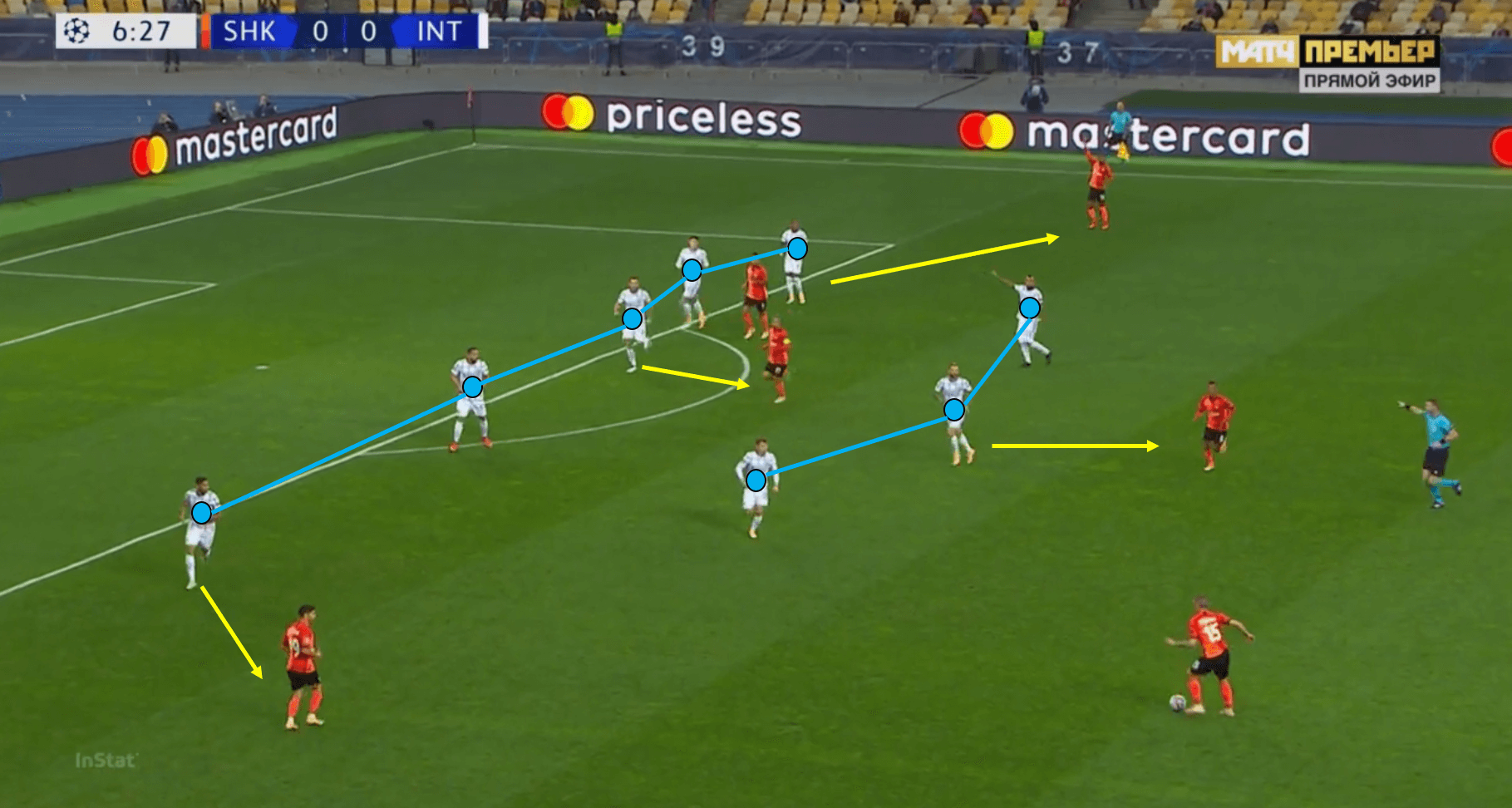
In this first method of defence from Inter, Kornienko finds himself just outside the final third for Shakhtar, with no immediate pressure being placed upon him. Inter’s shape is important to break down here – with both their midfield and defensive units remaining compact, leaving very little space in central areas. Another important note to make is the marking by Inter. Shakhtar, at this point, weren’t committing many players forward, giving Inter living to worry about. The Italians opted to keep their shape while keeping a watchful eye on potential passing options for Kornienko. The marking was not tight, but if any Shakhtar player in the shot above was to receive the ball, an Inter player is close enough to close them down instantly. The question here is, how do Inter win the ball back if they’re not initially pressing or marking tightly, whilst sat deep in their half? The answer is simple – triggers. Inter waited until Shakhtar attempted to build an attack in a wider position, immediately pressing and stepping further up the pitch. This method saw Shakhtar try to recycle possession numerous times before eventually being forced back to their keeper.
As the game progressed, Inter would find themselves the more dominant team, allowing them to deploy a higher line to keep Shakhtar in their own half. This was effective, as the hosts struggled to threaten the visitors. Throughout the game, Shakhtar had 42% possession, to Inter’s 58%. Of that 42%, just 35% of Shakhtar’s possession resulted in them breaking out of their own half.
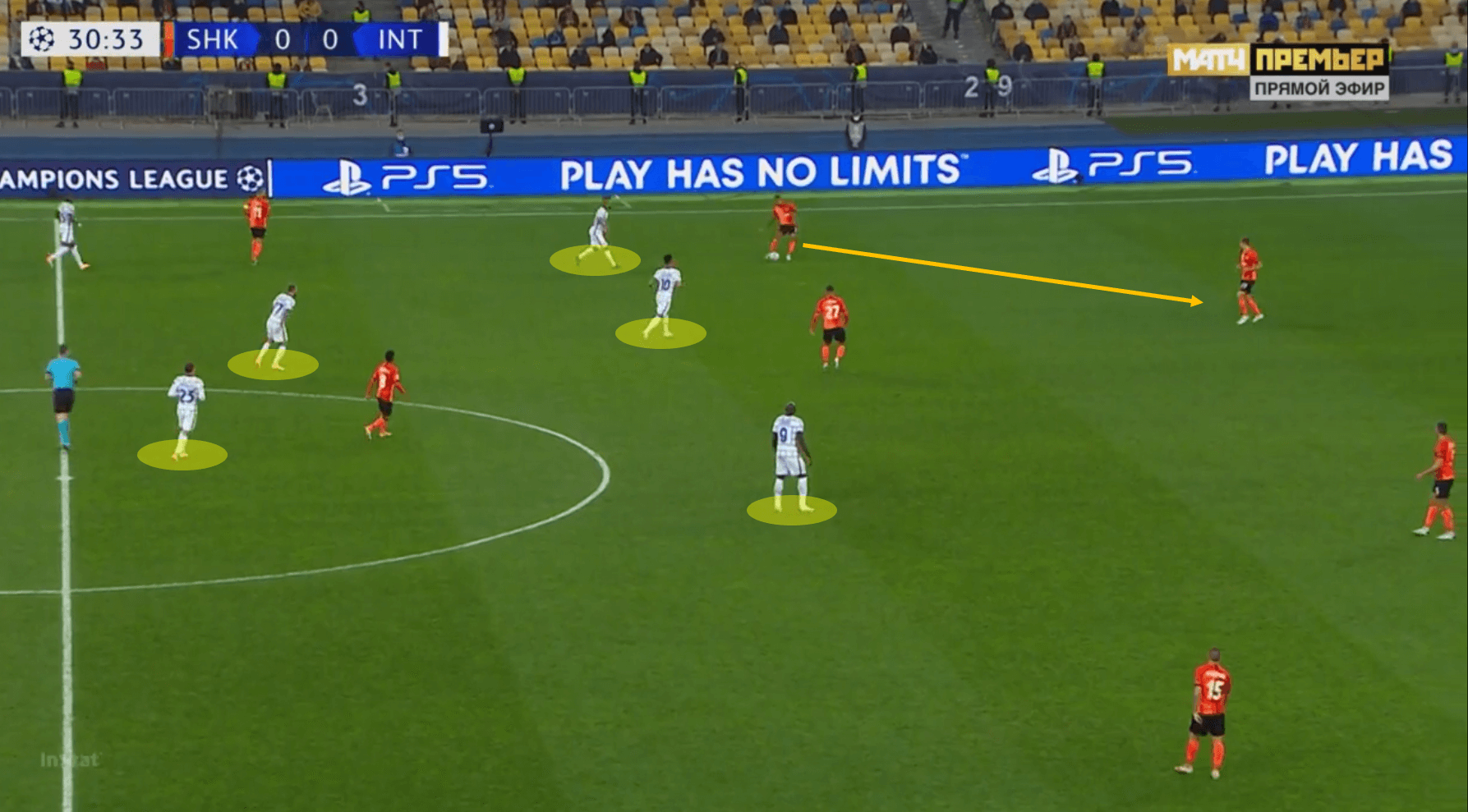
This analysis shows how Inter deployed a similar pressing system to the one previously discussed, but in a more promising position. They would often commit a midfielder up to press alongside the strikers to make a front three, with midfielders supporting behind. In this instance, they forced Shakhtar to retreat, playing a pass back to their centre half – the image below breaks down what happened next.
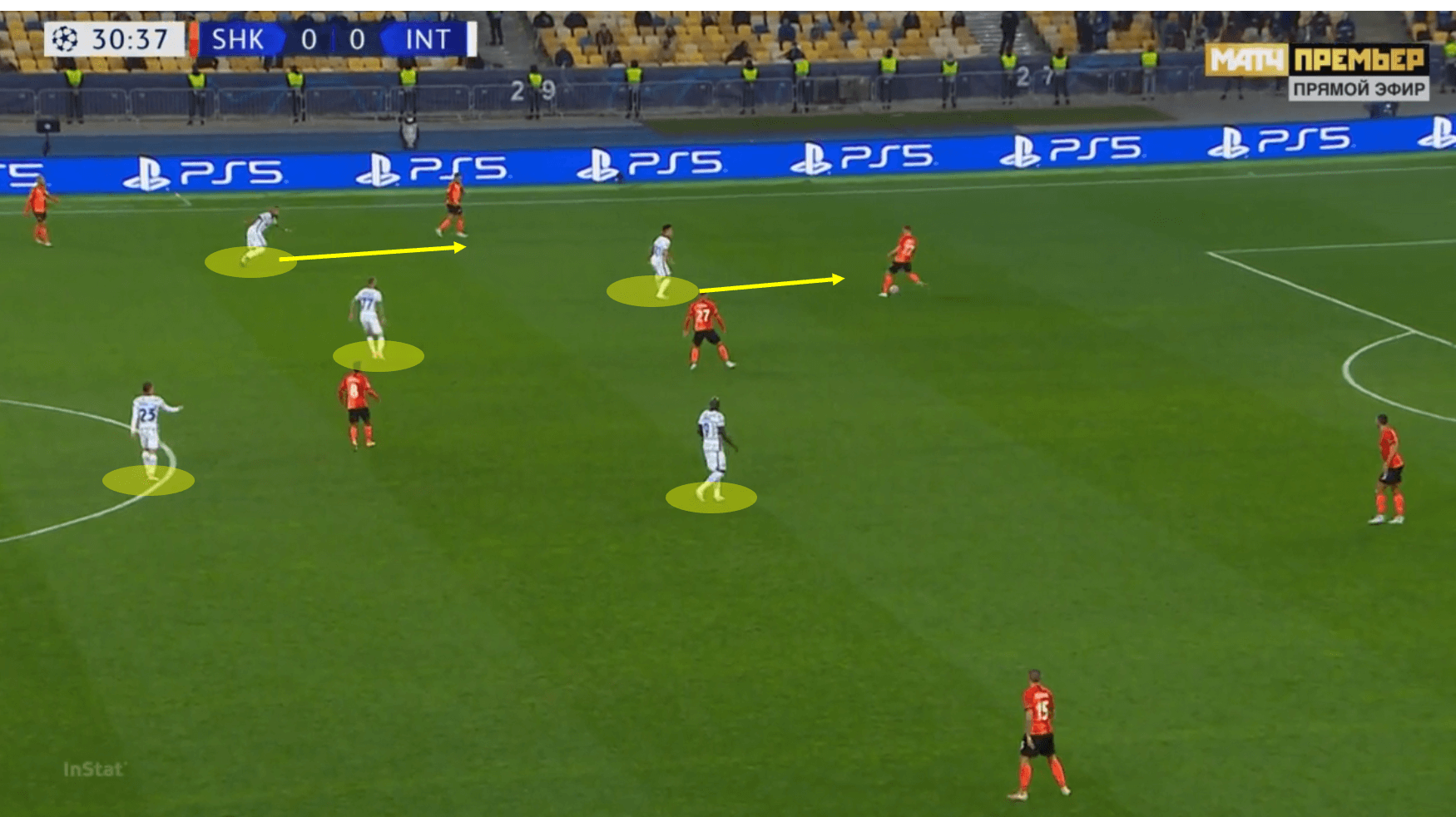
As the Shakhtar man received the ball from his right back, we saw an immediate forward-shift from Inter, allowing them to apply more pressure. Martinez closed down the centre back as he played a pass back into the feet of his right back. However, the pressure from Vidal on the left, and the supported marking from surrounding Inter players resulted in a turnover in possession in a dangerous area.
Inter made an impressive 40 recoveries in Shakhtar’s half alone, which was a major factor in them being able to control the game the way they did. As mentioned, the first section of the game saw Shakhtar take control of the game, and as we can see below, from the 15th minute all the way up to the hour mark, Inter truly controlled possession. The graph shows the share of possession through different stages of the game – Inter being represented by the blue graph line.
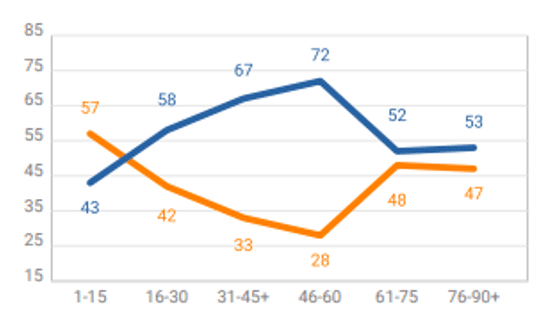
How Shakhtar kept Inter out
Despite having 58% possession, 52 attacks with 11 shots, and 34 attempted passes into Shakhtar’s penalty area, Inter just could not find that final product to take the lead. Furthermore, these statistics would suggest that Inter were camped around the edge of the Shakhtar box, using short passes to work space for a shot. When, in reality, Shakhtar occasionally found themselves defending much higher up than the data suggests.
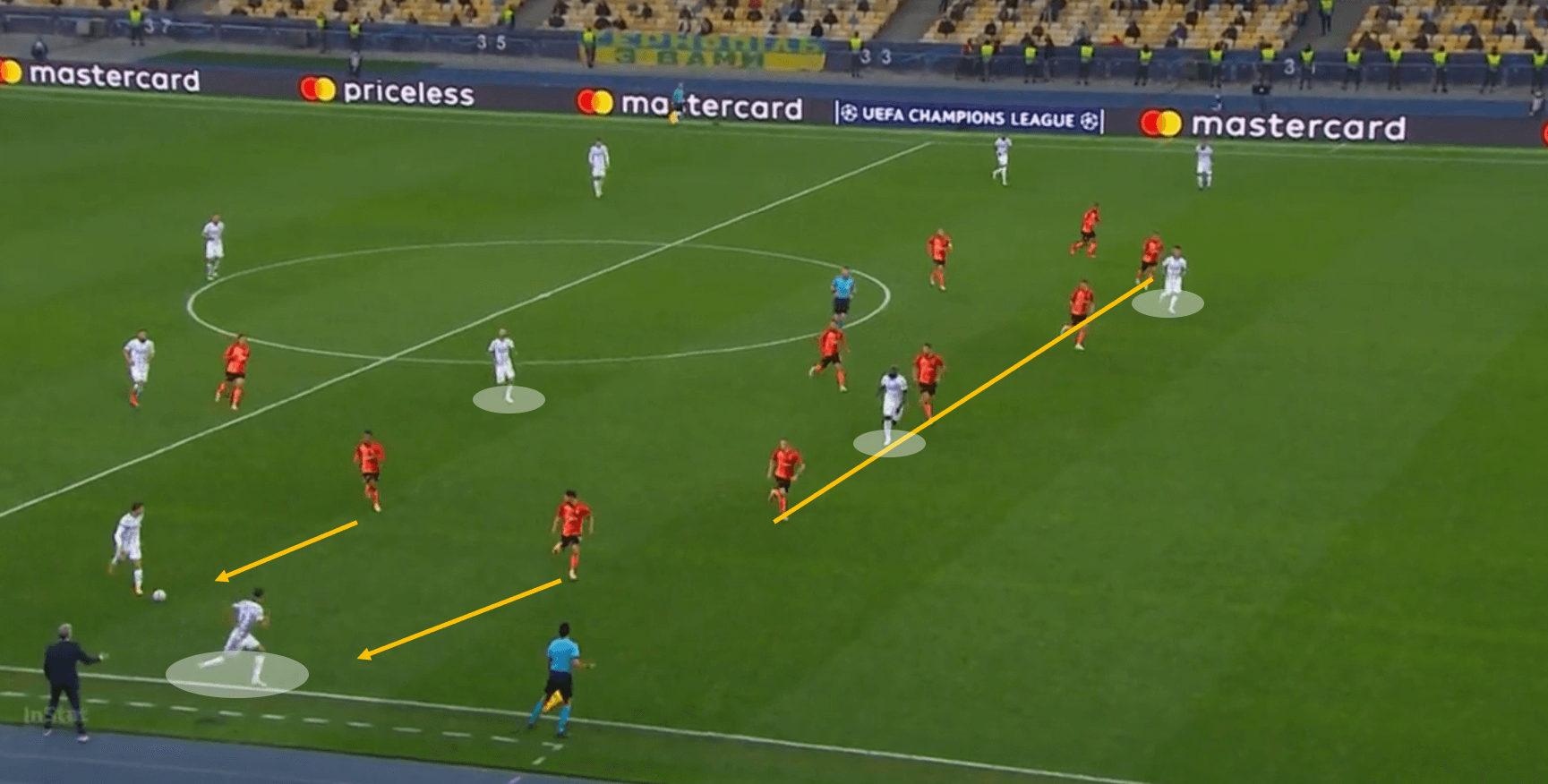
This analysis shows exactly that. Their organisation in this example is excellent, leaving little gaps for Inter players to get into that would cause any real danger. Their defensive line is straight to allow an offside element, their shape is narrow, and the three midfielders in front of the defence leave very little space for any Inter player to work in, if they attempted to. Furthermore, they did the basics right: pressing the man on the ball at a good angle to force them into a particular pass, with the closest passing option being tracked well to limit his availability. From an Inter perspective, they have too many players behind the ball to have any hopes of building a decent attack – unless a perfect pass found a perfectly-timed run of either Lukaku or Martinez.
Early in this tactical analysis, we mentioned how Shakhtar lined up in a way that would allow them to crowd the midfield in an attempt to limit Inter’s attacking flow. For the majority of the game, this paid off, as Inter sometimes resorted to long balls to bypass the busy midfield.
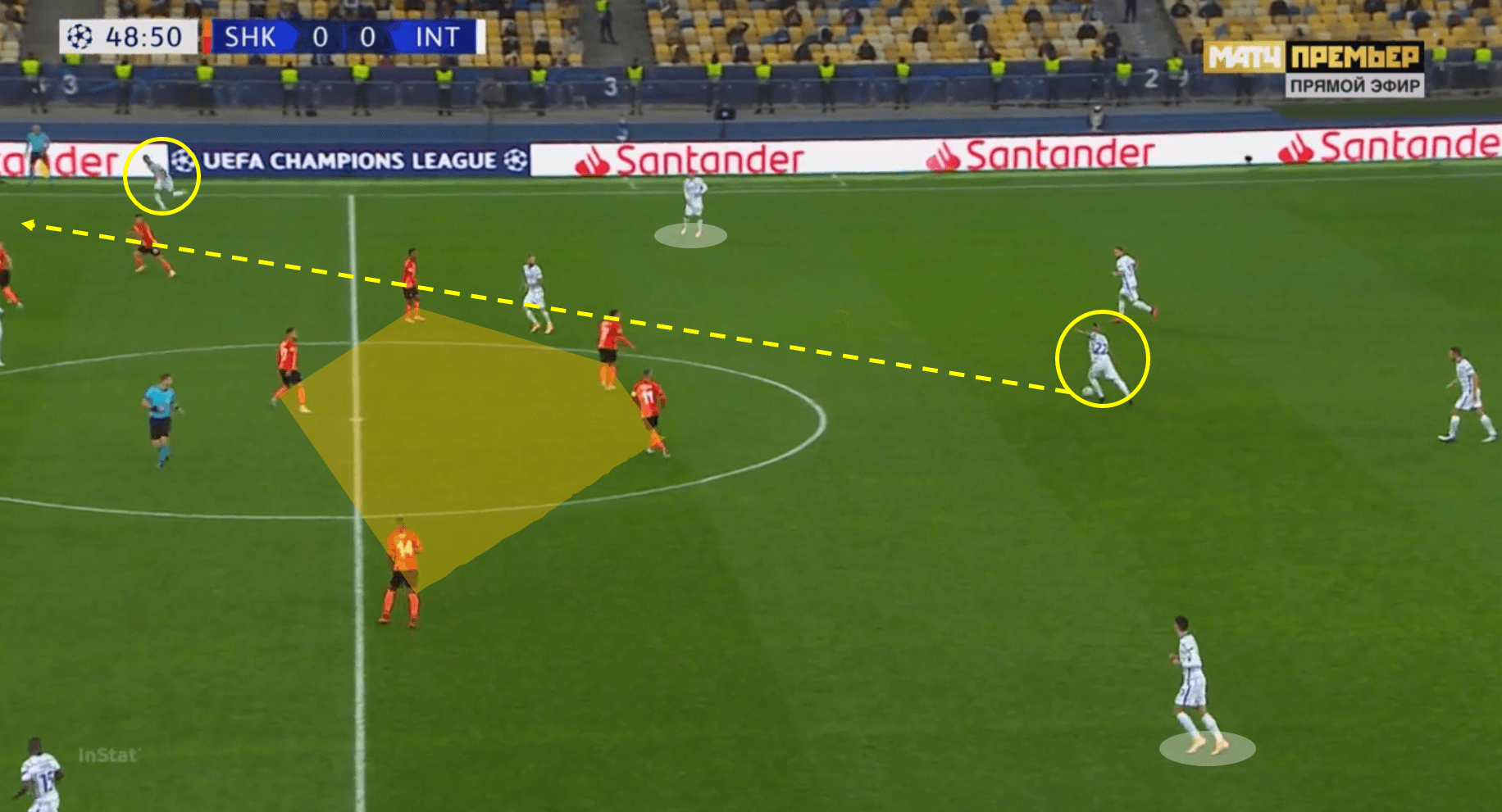
In this analysis, we see an example of Inter resorting to a more direct style of play to try and break into a scoring opportunity. In some cases, this is understandable. But given the options Vidal has at his disposal, perhaps going long wasn’t the best decision. Firstly, the pass would need to be inch-perfect to reach the wide runner who has two defenders closing in on him. Secondly, Inter have a player in a full-back position on each side of the pitch – a smarter move for Vidal would’ve been to quickly shift it to one of them, as they both have a great amount of space in front of them.
When considering Shakhtar’s role in this, their midfield unit is vital. The winger abandoned their station out wide to assist with the central players to force Inter to go wide, which worked – there is just one Inter player anywhere near the midfield group. This method is part of why Inter found frustration rather than goals. During the game, Inter found themselves making 49 long passes, with a number of them coming in similar situations to this one. This made it difficult for their creative midfielders to have any heavy influence on the game.
A close encounter in the final 30
The final half an hour of this fixture saw a more even contest, in terms of possession especially. The tempo was much slower when Inter had the ball, and Shakhtar were also in no hurry to get forward for the most part, although there were times when they attempted a long-ball to catch Inter off guard. Inter had spent a great amount of collective energy with their constant pressure and attack for a large portion of the game. Aware that Shakhtar would still have some considerable gas left in the tank, Inter took their foot off the pedal slightly to avoid the risk of being hit on the counter attack. Despite this, when they did have possession, they looked to use it deep in Shakhtar’s half, trying to piece together a combination of passes, often on the right-wing.
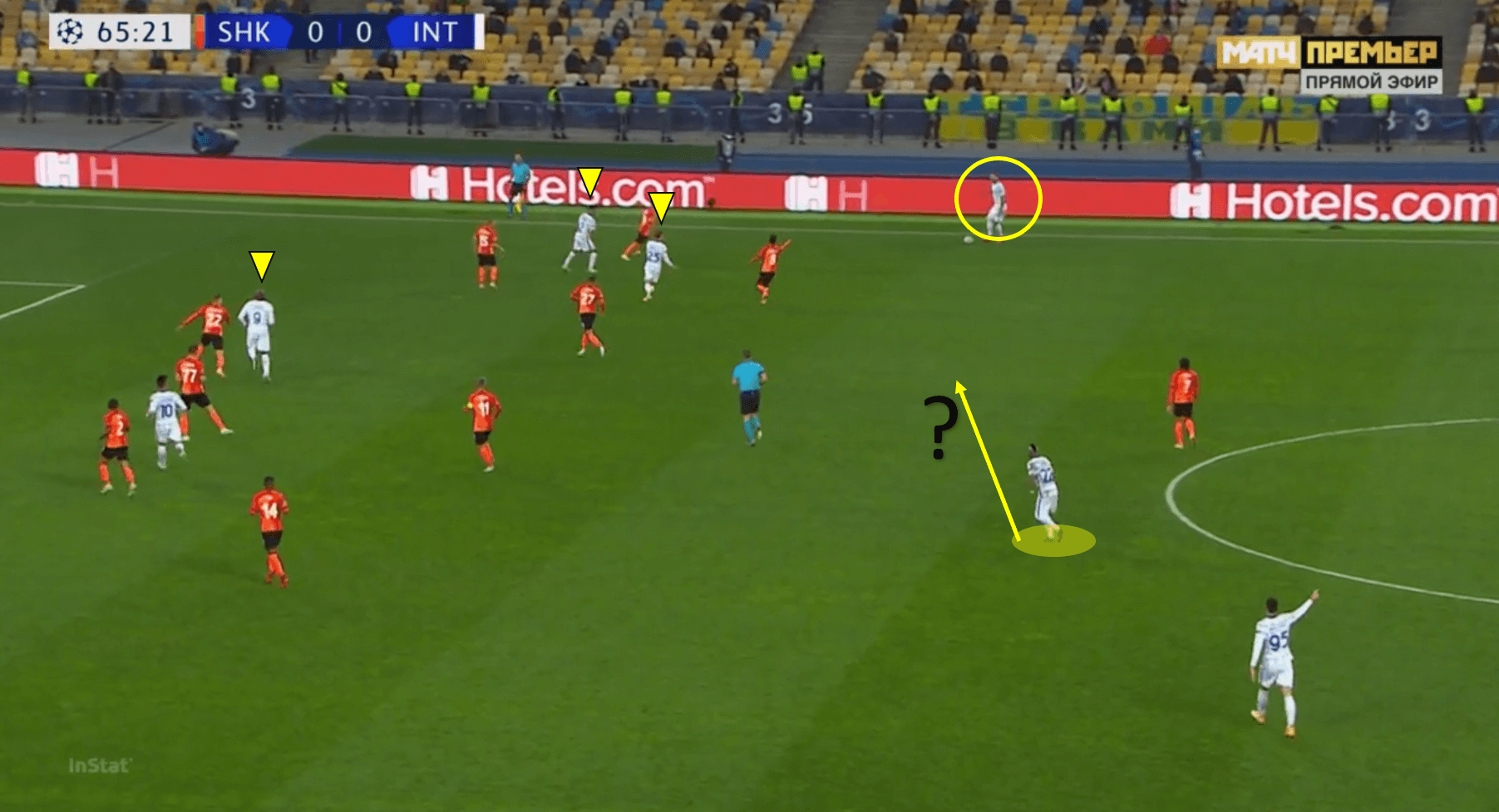
Immediately, it is noticeable that Shakhtar did not relax in their defensive discipline. A flat back line with a flat midfield bank just in front of it, leaving very little space for Inter to work in. Again, Inter were not overflowing with passing options, but they seemed to focus their attacks down the flanks, particularly the right flank. 43% of their attacks came down the right hand side of the pitch, but Shakhtar’s defending made it very difficult to break through, despite having three potential options to aim for. It is worth questioning Vidal’s positioning in this attack too. With plenty of space in front of him, closer to the man on the ball, you would assume he would drift into a position to become a passing option. The argument will be that Inter wanted to attack the flank, but having Vidal present in a more prominent position will have given them an alternative route to consider, giving Shakhtar something else to worry about.
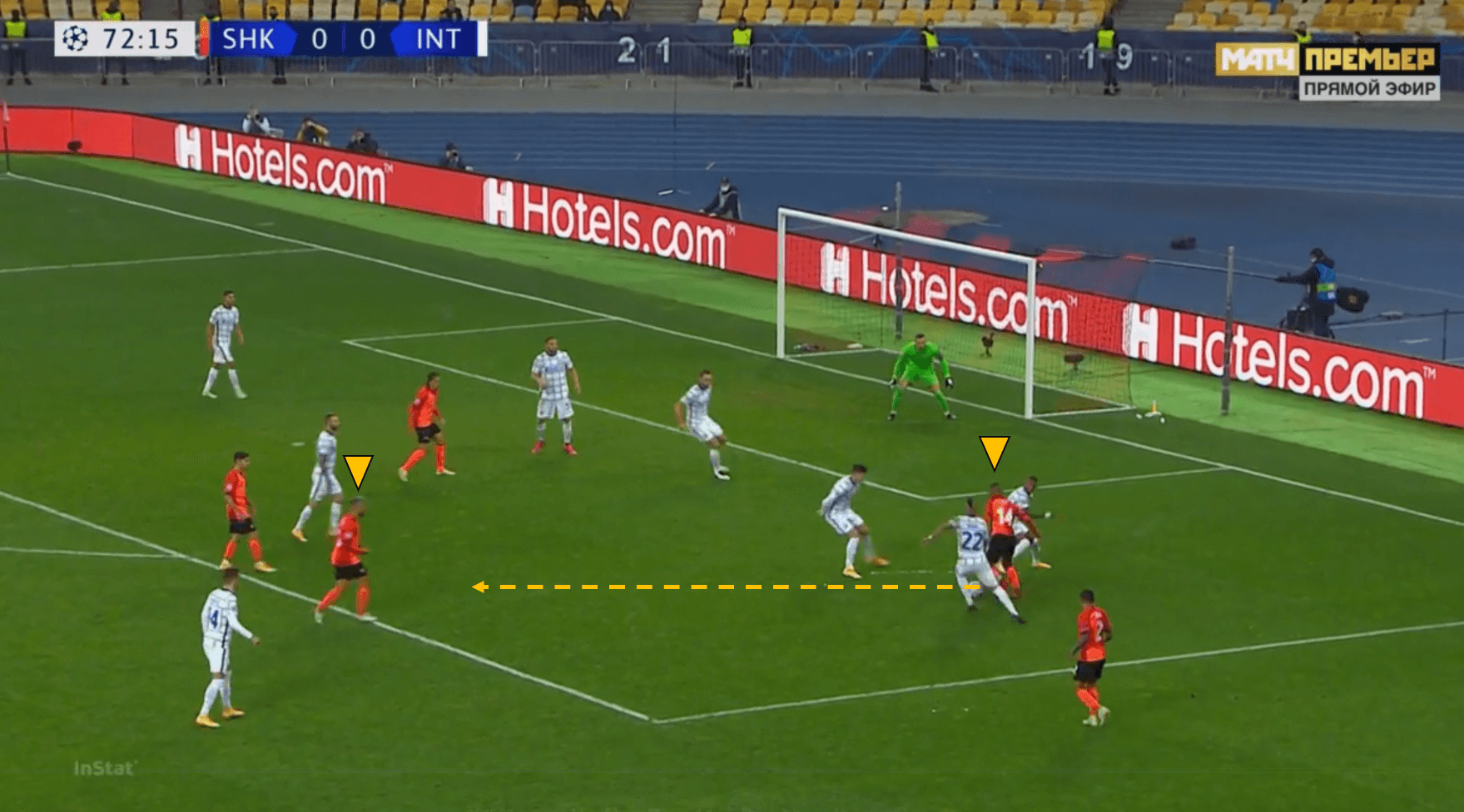
The image above is taken from one of the best chances Shakhtar had all night. At the feet of Tete, number 14, is the ball. After beating Vidal already and getting himself into a potentially dangerous area, he found himself surrounded by three Inter players. At this moment, Tete lays the ball off to Marlos, who is unmarked at the edge of the penalty area in a good position to take the shot on. His shot, however, was mis-hit and the attack came to nothing. The fact that this was one of Shakhtar’s best chances speaks volumes as to what their gameplan was – to avoid defeat. Credit goes to Inter here who remained organised in defence, swarmed Tete at the right time, and applied just enough pressure to Marlos to break the attack down.
Speaking of good chances, Inter had one of their best chances just minutes after the incident above. This was a second phase attack after Shakhtar cleared Inter’s initial delivery, only to be met by an Ashley Young cross.
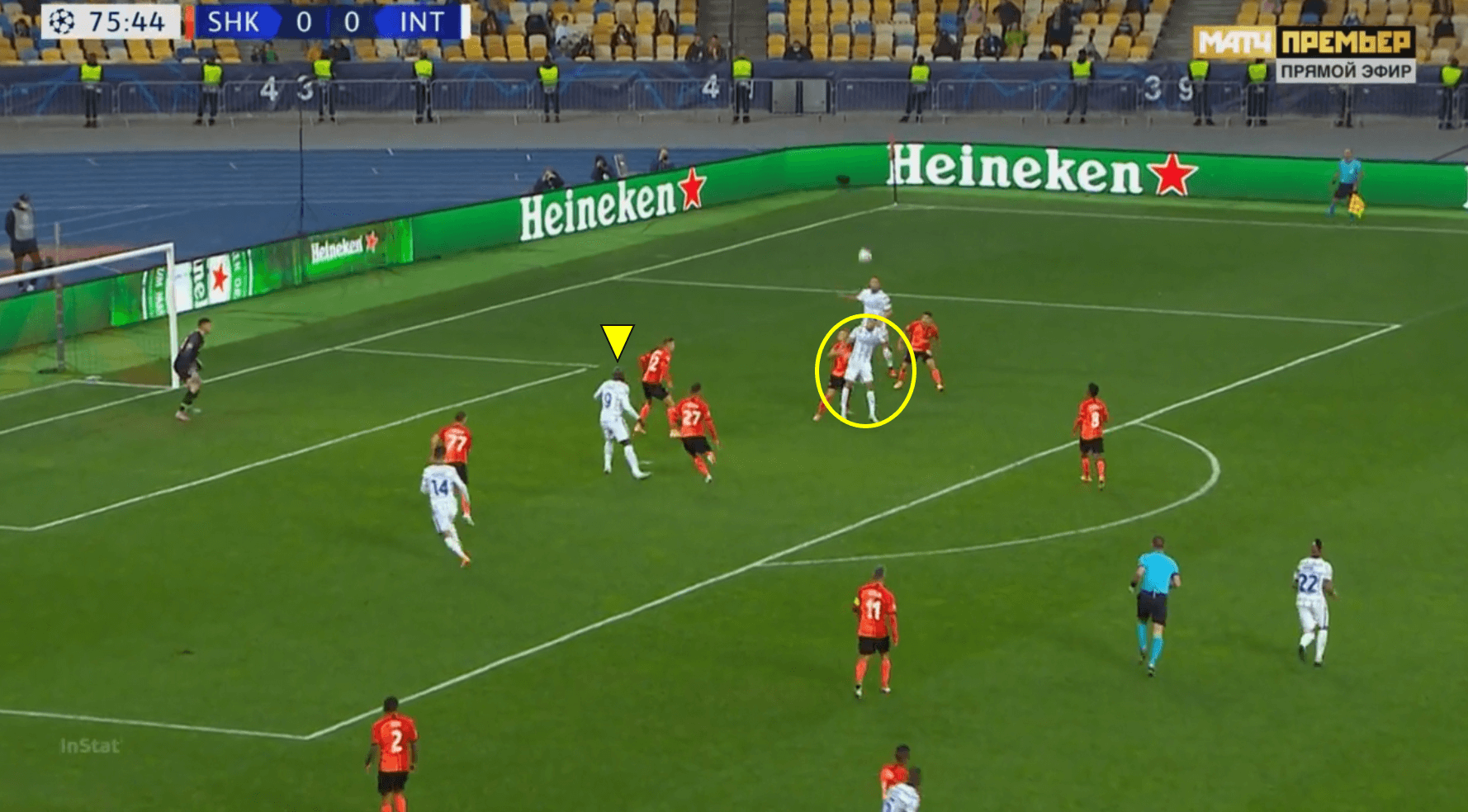
Understandably, Inter fancied their chances with crosses. Their tendency to play in wide areas and the presence of a number of physically capable players is a good combination for the crossing strategy. This particular cross arrived from the right boot of Young, from the left-hand side. Hakimi was the man to meet the header first, cleverly cushioning his header down for Lukaku on the penalty spot. The Belgium international oddly opted to chest the ball down to control it, rather than heading the ball goalwards first-time. This resulted in a coming-together with a Shakhtar defender, but not enough for a penalty, despite the Inter claims. This was not the first time Inter attempting this attacking method during the game. A total of 19 crosses were attempted, with 9 of them being accurate.
Conclusion
Some may view this match as a poor Inter performance, and in some ways, it was. But they did show quality in some areas and displayed an ability to dominate a game and remain defensively sound. Credit has to go to Shakhtar for a brilliant defensive performance. While some may criticise their defensive approach, from an analytical standpoint, they achieved exactly what they set out to – stop Inter from scoring. Four points from two games is a strong start for the Ukrainian side, but Inter will be disappointed to still be winless in the group stage.






Comments